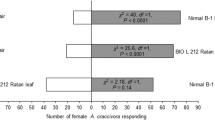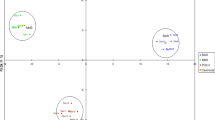Abstract
The mandarin orange or portugal, Citrus reticulata (Blanco), is unattractive as a forage material for the leaf-cutting ant, Acromyrmex octospinosus (Reich) while pineapple orange, Citrus sinensis (L.), is quite attractive. Lipid and non-lipid components were separated from portugal whole leaf extracts. Bioassays revealed the lipid fraction to be less attractive to the ants. This fraction was further separated using preparative layer chromatography into polar and non-polar lipid constituents. Two non-polar lipid fractions, Rf 0.5–0.7 and Rf 0.7–1.0, were shown to be the most deterrent constituents of portugal leaves to A. octospinosus.
Résumé
Le mandarinier, Citrus reticulata (Blanco), n’offre pas de matériel fourrager attrayant pour la fourmi-parasol, Acromyrmex octospinosus (Reich), tandis que l’oranger (variété ananas), Citrus sinensis est très attrayant. Des composants lipidiques et non lipidiques ont été séparés d’extraits de feuilles entières de mandarinier. Des épreuves biologiques ont révélées que la fraction lipidique était moins attrayante pour les fourmis. En outre, utilisant la Chromatographie en couche fine, cette fraction a été séparée en éléments polaires et non polaires. On a démontré que deux fractions de lipidiques non polaires, Rf 0,5–0,7 et Rf 0,7–1,0, étaient les constituants des feuiles de mandarinier les plus préventifs contre A. octospinosus.
Similar content being viewed by others
References
Ben-Aziz A. (1967) Nobelitin is main fungistat in tangerines to Mal Secco. Science 155, 1026–1027.
Cameron J. W., Carman G. E. and Soost R. K. (1968) Differential resistance of Citrus species hybrids to infestation by the California red scale, Aonidella aurantii (Mask.). J. Am. Soc. Hort. Sci. 94, 694–696.
Cherrett J. M. (1968) The foraging behaviour of Atta cephalotes: 1. Foraging pattern and plant species attacked in tropical rain forest. J. Anim. Ecol. 37, 387–403.
Cherrett J. M. and Peregrine D. J. (1976) A review of the status of leaf-cutting ants and their control. Ann. appl. Biol. 84, 124–128.
Dadd R. H. (1960) Observations on the palatability and utilisation of food by locusts with particular reference to the interpretation of performance in growth trials using synthetic diets. Ent. exp. appl. 3, 283–304.
Dethier V. G., Barton-Browne L. and Smith C. B. (1960) The designation of chemicals in terms of the responses they elicit from insects. J. Econ. Ent. 54, 134–136.
Duncan D. B. (1955) Multiple range and multiple F tests. Biometrics 11, 1–42.
Folch, J., Lees M. and Sloane-Stanley G. H. (1957) A simple method for isolation and purification of total lipids from animal tissues. J. Biol. Chem. 226, 497–509.
Gebreyesus T. and Chapya A. (1983) Antifeedants from Clausenia anisata (Willd.) Hook F. Ex Benth (Rutaceae). In Natural Products for Innovative Pest Management (Current Themes in Tropical Science, Vol. 2), (Edited by Whitehead D. L. and Bowers W. S.) pp. 237–242. Pergamon Press, U.K.
Hubbell S. P. and Wiemer D. F. (1983) Host plant selection by an attine ant. In Social Insects in the Tropics. (Edited by Jaisson P.) Vol. 2, pp. 133–154. University of Paris Press, Paris, France.
Jones V. G. (1983) Investigation of the acceptability of Citrus reticulata as a forage substrate for the leaf-cutting ant, Acromyrmex octospinosus. M. Phil. Thesis, The University of the West Indies, St. Augustine; Library; Unpubl. 117 pp.
Littledyke M. and Cherrett J. M. (1975) Variability in the selection of substrate by the leaf-cutting ants Atta cephalotes (L.) and Acromyrmex octospinosus (Reich) (Formicidae: Attini). Bull. ent. Res. 65, 33–47.
Littledyke M. and Cherrett J. M. (1978) Defence mechanisms in young and old leaves against cutting by the leaf-cutting ants Atta cephalotes (L.) and Acromyrmex octospinosus (Reich) (Hymenoptera: Formicidae). Bull. ent. Res. 68, 263–271.
Mudd, A., Peregrine D. J. and Cherrett J. M. (1978) The chemical basis for the use of citrus pulp as a fungus garden substrate by the leaf-cutting ants Atta cephalotes (L.) and Acromyrmex octospinosus (Reich) (Hymenoptera: Formicidae). Bull. ent. Res. 68, 673–685.
Munakata K. (1970) Insect antifeedants in plants. In Control of Insect Behaviour by Natural Products. (Edited by Woods D. L., Silverstein R. M. and Nakajima M.) pp. 179–187. Academic Press, New York.
Pollard G. V., Riley R. and Wattie E. (1983) Preliminary investigations on the selection of citrus species by the leaf-cutting ant, Acromyrmex octospinosus (Reich) (Formicidae: Attini). Trop. Agric. (Trinidad) 60, 348–352.
Rees C. J. C. (1969) Chemoreceptor specificity associates with choice of feeding site by the beetle, Crysolina brunsvicensis, on its food plant Hypericum hirsutum. Ent. exp. appl. 12, 565–583.
Rockwood L. L. (1976) Plant selection and foraging patterns in two species of leaf-cutting ants, Atta. Ecology 57, 48–61.
Russell G. E. (1978) Plant Breeding for Pest and Disease Resistance. Butterworths, London.
Soo Hoo C. F. and Fraenkel G. (1966) The selection of food plants in a polyphagous insect, Prodenia eridania (Cramer). J. Insect Physiol. 12, 693–709.
Stradling D. J. (1978) The influence of size on foraging in the ant, Atta cephalotes and the effect of some plant defence mechanisms. J. Anim. Ecol. 47, 173–188.
Waller D. A. (1982) Leaf-cutting ants and live oak. The role of leaf toughness in seasonal and intraspecific host choice. Ent. exp. appl. 32, 146–150.
Author information
Authors and Affiliations
Rights and permissions
About this article
Cite this article
Jones, V., Pollard, G.V. & Seaforth, C.E. Chemical Deterrency of Citrus reticulata (Blanco) to the Leaf-Cutting ant, Acromyrmex octospinosus (Reich). Int J Trop Insect Sci 8, 99–102 (1987). https://doi.org/10.1017/S1742758400007050
Received:
Revised:
Published:
Issue Date:
DOI: https://doi.org/10.1017/S1742758400007050
Key Words
- Citrus reticulata
- mandarin or portugal
- leaf-cutting ants
- Acromyrmex octospinosus
- plant selectivity
- chemical deterrents




